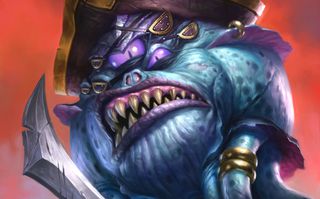
If you’ve played any Hearthstone at all since the release of Mean Streets of Gadgetzan, then you will have encountered Patches the Pirate. Or more specifically, you will have watched in horror as a small cannon fires him out of your opponent’s deck and into your face on turn one. “I’m in charge now!” shouts the cutlass-wielding, tricorn hat-wearing wearing observer. And he’s not wrong, as evidenced by the huge number of pirate decks on the ladder. Such is his dread power that Patches was even banned from the recent Batstone tournament, organised by former world champion James “Firebat’ Kostesich, despite the event being intended to showcase as many of the new cards as possible.

The artwork for Patches the Pirate was created by James Ryman. “Once we got the first round of art in, I think it was [Ben] Brode who showed it to the rest of the team and everybody was just loving it,” says game designer Matt Place. “It was one of the big hits, along with Finja, the Flying Star.”
Patches is strong for several reasons. At first glance, a 1/1 with Charge may not instill terror. After all, Stonetusk Boar exists. But the point of Patches is that unless you’re unlucky enough to draw him in your opening hand, then he’ll be placed onto the board for free as soon as you play another minion with the “Pirate” tag. So, when playing a pirate deck you usually get Patches early and for no cost. And in a game like Hearthstone in which early board control is crucial, that’s a huge deal.
Patches helps you trade with your opponent’s creatures or do chip damage to their hero that may make the difference between winning and losing. He also effectively thins your deck by a card because he usually pops out for free in the first couple of turns.
That’s the kind of small advantage pro players love to talk about, because it means you’re slightly more likely to draw into your most valuable cards (ie ones that aren’t Patches) as the game goes on. But as popular streamer Andrey “Reynad” Yanyuk noted in his video about the current meta, thinning your deck isn't all that relevant if you’re planning to end the game by turn six anyway.
MAKING A MONSTER
What Patches isn’t, is a surprise. Prior to Mean Streets’ release, most pundits were predicting the card would be insanely strong. “There is no chance this card will fail to be good,” wrote our own expert, and Blizzard’s designers were clearly well aware of Patches’ potential, because they’d already spent so long trying to balance him. “Probably almost two years,” senior game designer Matt Place told me when we spoke last week. “That might be the record. It’s certainly one of the longest running development cycles of any card.”
Back then it was not a legendary card. So you can imagine how powerful that was.
Prior to the release of Mean Streets, game director Ben Brode took to Reddit to give some insight into the design process that had led to Patches. He explained that the card had begun life way back before Blackrock Mountain, when it was due to be a neutral 1/1 dragon that would pop out of your deck after you’d played your first dragon. Place tells me that the design team is always looking to blow people’s mind in fun ways that fit with the next set’s theme. However, free dragons turned out to be a little bit too good.
“It was totally crazy,” Place says. “Back then, by the way, it was not a legendary card. So you can imagine how powerful that was, especially with Priest also having a 1-Mana dragon. It was a lot of power early on. Priest had the craziest way to build the deck because on turn one you could generate four power of attack.” Having been dropped from Blackrock Mountain, the card was then earmarked to appear in The Grand Tournament three months later. During this period it went through more iterations, becoming a legendary pirate, and getting tested as a 2/1. Eventually the team settled on a 1/1 with Charge, but there were still balance problems.
The biggest gaming news, reviews and hardware deals
Keep up to date with the most important stories and the best deals, as picked by the PC Gamer team.
THE SECOND CUT IS THE DEEPEST
One of the reasons a power card like Patches is exciting is because it has the potential to unlock previously overlooked synergies. However, late during testing it became clear that it was too strong in conjunction with some other the old pirate cards. One-eyed Cheat is a 2-Mana 4/1 that gains Stealth whenever you play a Pirate. Ship’s Cannon is a 2-Mana 2/3 which deals 2 damage to a random enemy whenever you summon a pirate. (Knife Juggler on crack, basically.) Both of those would have been degenerate when combo’d with Patches.

And so the decision was made to cut the card again—this time incredibly close to release. “The art was actually in the cinematic [trailer] for The Grand Tournament,” says Place. “When they decided to push the card off, that became what we now know as Skycap’n Kragg.” The designers still loved the idea and refused to give up. “It kept popping up even once it was booted out of The Grand Tournament,” says Place. “It had different names and concepts.” At one point it became a Warrior class card, jokily named Dean’s First Mate after another one of the designers, which eventually became N’Zoth’s First Mate instead.
Place says it isn’t uncommon for cards to undergo long gestations. He tells me that Drakonid Operative’s ability to Discover a card in your opponent’s deck was originally intended for the League of Explorers, but not as a Dragon card. The Druid legendary Kun the Forgotten King’s Mana refresh ability was also a separate thing before someone came up with the idea of turning it into a Choose One effect and giving players the chance to also pick armor gain. “There are always cards that one or more designers are really excited about that may or may not make sense for that set,” he says. “There are a lot of cool ideas that bounce in or out.”
Often, cards need to wait for the right meta conditions and a set with a suitable theme. In Patches' case, that meant Mean Streets of Gadgetzan. One-eyed Cheat and Ship’s Cannon had finally rotated out, and the fact that Mean Streets was the second set to be part of Standard meant that there was a bigger total card pool and so less chance of Patches having a disproportionate impact. The dockside theme also provided a perfect setting for pirates.
Place tells me how the look of Patches finally got nailed: “We were brainstorming some ideas for pirates, and Dave Kosak—he’s worked on WoW since the beginning—came up with this pirate who’s a beholder, which was hilarious to all of us in the room. The idea he has more eyepatches than most pirates even have eyes. It all came together so perfectly. I love the voice lines. Patches says ‘Aye aye!’ when he attacks. He probably should have said ‘Aye aye aye aye aye!'”
THE EYES HAVE IT
I ask Place if he’s happy with where Patches has landed in terms of power. “It’s been meeting expectations in a lot of ways,” he replies, “but we’ll see how it plays out.” In terms of how to counter pirate decks, most players have wised up to using weapon destruction, cheap AoE spells, and a lot of healing. Place tells me he’s taken to running Elven Archers to pick off low health pirates. “I’ve also been having a lot of success buffing my Taunt minions in Warrior”, he says, before admitting that the Reno Druid he’s working on has “been horrible.”
Patches has been meeting expectations in a lot of ways, but we’ll see how it plays out.
A bigger surprise is seeing how many players still forget to attack with Patches when he’s summoned. “Pretty hilarious, but it happens to all of us,” says Place. “Reynad was literally talking about it, while then playing a pirate and forgetting to attack with Patches.” That mistake gives you a sense of just how alien the mechanic initially felt, but as the card will be sticking around until the 2018 Standard rotation, we’re going to have plenty of time to get to grips with it.
Regardless of whether you think Patches is OP, there’s little doubt that this kind of leftfield design is a big reason why new Hearthstone sets are so eagerly anticipated. Game director Eric Dodds once told me that unless new cards scare the team, then they’re doing it wrong. Place says he also likes to be scared: “I love those types of designs where, when someone says them to you, you’re like ‘It jumps out of your deck? Oh my, that sounds insane.’” He took a long time to get here, and we'll probably be sick to death of him by the time he leaves, but this is Patches time.
With over two decades covering videogames, Tim has been there from the beginning. In his case, that meant playing Elite in 'co-op' on a BBC Micro (one player uses the movement keys, the other shoots) until his parents finally caved and bought an Amstrad CPC 6128. These days, when not steering the good ship PC Gamer, Tim spends his time complaining that all Priest mains in Hearthstone are degenerates and raiding in Destiny 2. He's almost certainly doing one of these right now.
Most Popular


